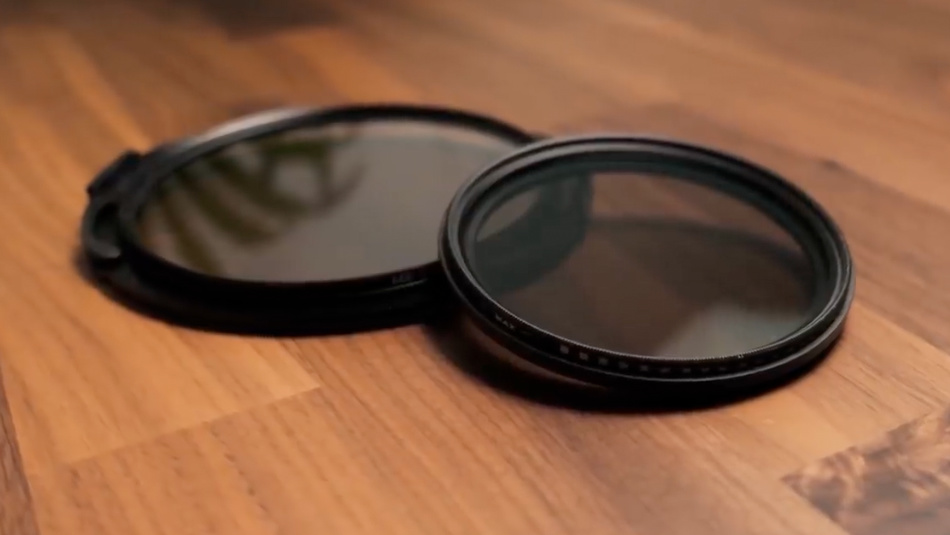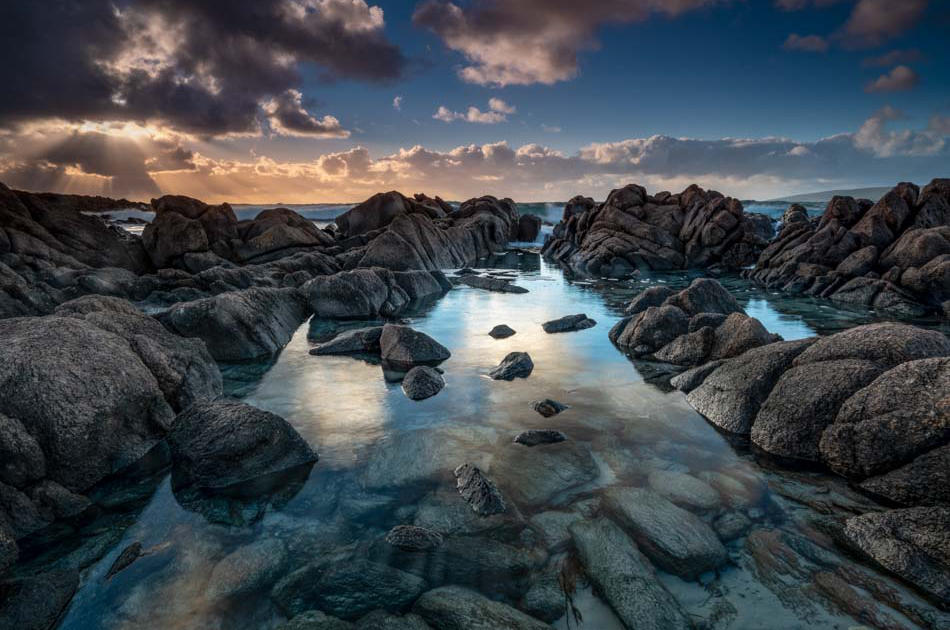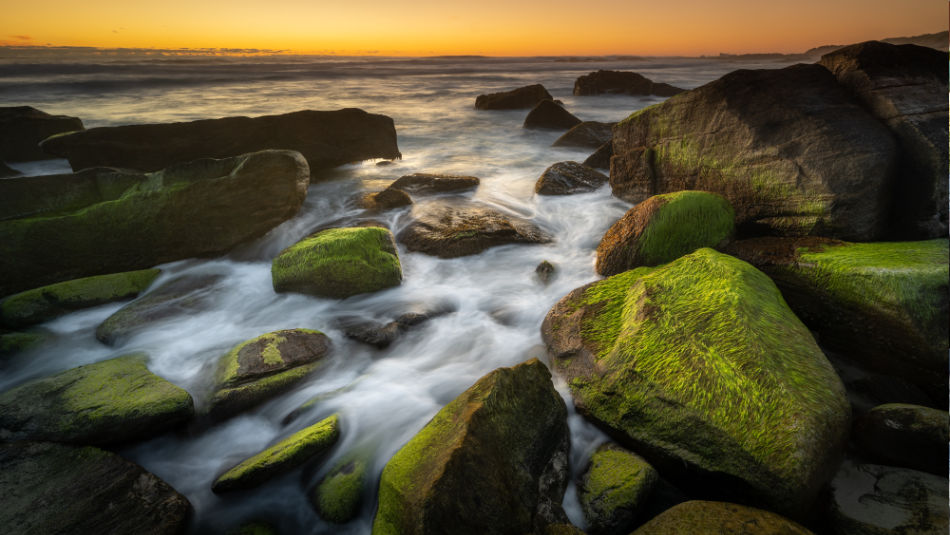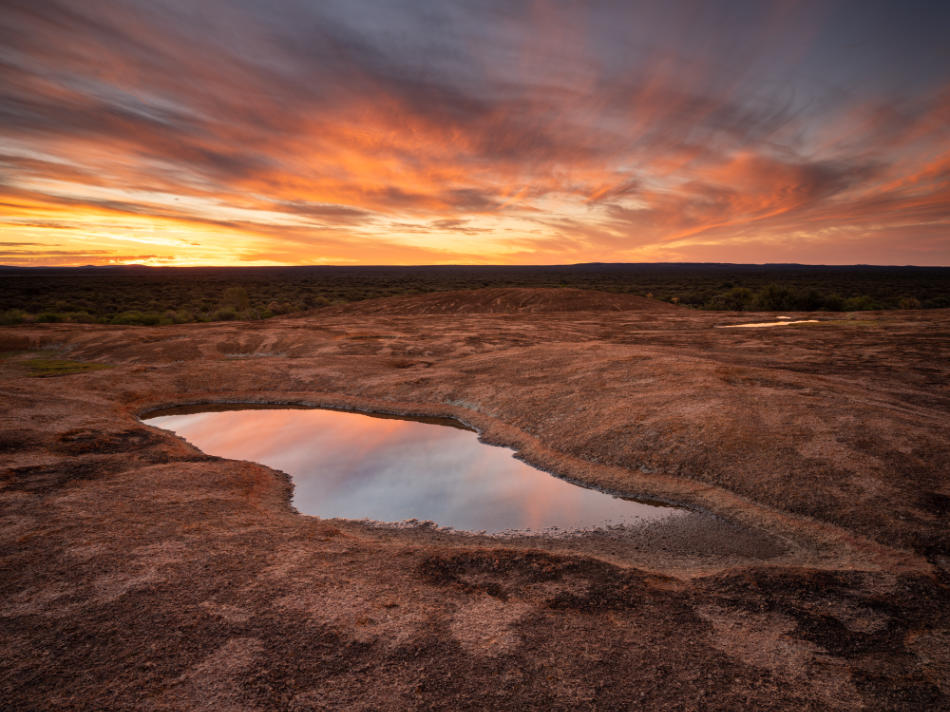I love finding images to shoot at the beach. But my seascape photos were transformed when I started using Circular Polarizers.
A Circular Polarizer reduces glare, which is distracting in a seascape, making the scene more pleasing to view. A CPL also enhances textures and patterns in rocks and cuts through reflections on the water’s surface, allowing the camera to capture detail underneath, improving seascape photos.
When I head off the beach to capture seascape picture, these are the filters I use:
- Circular Polarizer (CPL)
- Hard Grad Neutral Density Filter (0.6 and 0.3)
- Reverse Neutral Density Grad Filter
- Horizon ND Grad
- 6-stop ND Filter
But the Circular Polarizer is the filter that has the most significant impact on the seascapes I capture.
A Circular Polarizer is a Must-Have Filter for Capturing Seascapes
As light from the sun travels through the atmosphere, it’s scattered by the particle in the air. As a result, the wavelengths of the scattered light are orientated in multiple directions. The human eye and the camera see this as glare and reflections in a scene.
This is particularly noticeable as the light bounces off objects with wet or shiny surfaces.
There’s lots of water at the beach that create plenty of wet surfaces, like rocks, wet sand, and the surface of the seawater itself. So glare and reflections can be an issue when capturing seascapes.
This is where a Circular Polarizer can help.

What is a Circular Polarizer?
A Circular Polarizer (CPL) is a glass filter that reduces the impact of scattered light by only allowing wavelengths in the same parallel orientation to pass through. As the polarizer is rotated, it reduces the glare in the scene and reflections from wet or shiny surfaces.
Most Circular Polarizers are round but also come in square filter form.
I recommend getting a round filter as they are easier to mount to your lens and simpler to use.
How Does a Circular Polarizer Improve Seascapes?
A Circular Polarizer reduces distracting glare and reflections in a seascape. With a CPL attached, a camera can capture details under the water, improving the foreground of an image. Rock textures, patterns in the sand, and colors are all features in a seascape image that are enhanced with a polarizer.
A Polarizer Reduces Glare
There’s water everywhere at beaches. There’s lots of water sitting in pools and creating wet surfaces where a Polarizer can be beneficial.
As the waves push the water up the beach, the sand and rocks close to the water’s edge get wet.
These wet surfaces bounce brighter light and glare off them. Any glare within a scene can be distracting and unpleasant to view, weakening your seascape picture.

Mounting a Circular Polarizer to your lens will reduce the glare from these reflective surfaces, minimizing distractions and enhancing the textures and patterns in those seascape elements.
A Polarizer Cuts Through Reflections
In addition to glare, you often get reflections off large bodies of water like the sea and rock pools often featured in the foreground of seascape images.
With a Circular Polarizing Filter mounted to your lens, reflections are significantly reduced and, in some cases, removed.
Decreasing the amount of reflection coming off the water’s surface allows the camera to pick up parts of the scene beneath the water that can be seen from above the surface – for example, submerged rocks, seagrass, coral, and other sea life.

In the image above, I used a CPL to remove the reflection from a pool of water at Smith’s Beach.
Allowing the camera to see the scene under the water improves the foreground in the image, making the photo more interesting.
Note that the camera can see detail beneath the water underneath the camera (perpendicular). However, the reflection is more prominent on the water, at a more acute angle, away from the camera.
A Polarizer Enhances Colors
By effectively cleaning up the light, polarisers can enhance some of the colors in a seascape scene. In particular, the vibrancy of greens and blue hues is increased.
Green, aqua, and blue are colors often found in seascape scenes. A polarizer will improve the quality of these colors as you capture the shot, making them easier to edit in post-production.

In my experience, green moss is more prominent in the image, and the aqua and blues of the ocean have a richer tone when using a Circular Polarizer.
A Polarizer Helps See Through Haze and Sea Mist
When you are shooting around the coast, you’ll sometimes experience haze and sea mist created by the ocean waves and blown inland by the sea breeze.
For some shots, haze can add to the mood of a photo. However, if you feel it negatively impacts the picture, you can use a Polarizer to cut through the haze so more detail in the scene is captured.
How do you use a Circular Polarizer for Seascapes?
Rotate the ring of the Circular Polarizer while viewing the scene through the EVF or Live View on the back screen. Look at how reflections and glare from some surfaces change as you rotate the CPL ring. Stop adjusting the ring when you are happy with the polarizer’s effect on the image.
Mounting a screw-on Circular Polarizer is relatively simple.
Beaches can be sandy places, so ensure no sand particles or dust are on the glass or around the thread.
Gently screw the filter directly onto the front of the lens, being careful not to cross-thread the filter or over-tighten it.
For most filter holder systems, the polarizer will attach to the filter holder, which then mounts to the lens adapter.
In both cases, the polarizer can be adjusted while mounted on the lens so you can observe how the image changes as you rotate the CPL ring.
Is a Circular Polarizer Filter necessary for Seascape Photography?
A Circular Polarizer is not only helpful when it comes to improving your seascapes, but it’s an essential filter because, unlike many other enhancements you can make in post-production, a polarizer’s effect on a scene can’t be replicated using editing software or AI.
So if you want to remove glare or reflections from a scene, you must apply a polarizing filter as you capture the photo.
When shouldn’t you use a Circular Polarizer with Seascapes?
Polarisers are great for removing unwanted reflections. However, reflections can be a feature in the scene that draws in the eye of the viewer. If you want to capture a reflection in your photo, you must rotate the CPL to a point where the reflection remains or remove the polarizer from the lens.

The same applies to haze or mist that contributes to the mood of your image. The polarizer’s impact on the light varies as you continue to rotate it.
You can position the ring so it partially cleans up the scattered light and has the desired effect in the image.
QUICK RECAP
Circular Polarizers reduce glare from wet rocks and sand often found around beaches.
Polarizers can remove distracting reflections from the water surface in a seascape image, so detail from beneath the water can be captured.
A CPL can cut through the haze and increase the vibrancy of colors often found in seascapes.
A Circular Polarisers effect on an image can not be replicated with editing software in post-production. Hence, a polariser is essential to the photographer’s filter kit for seascapes.


